
Tube SDCs on Drum Overheads
Sunday, October 7th, 2012 | by matthew mcglynn
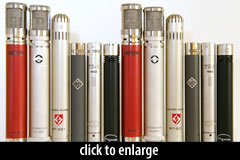 The final chapter of our three-part tube SDC roundup has arrived: in this article, we’ll test the Lauten Torch, Mojave MA-100, Chameleon Labs TS1, Avantone Pro CV-28, Sterling ST-44, and Telefunken Ela M 260 on drum overheads, with both Cardioid and Omni capsules.
The final chapter of our three-part tube SDC roundup has arrived: in this article, we’ll test the Lauten Torch, Mojave MA-100, Chameleon Labs TS1, Avantone Pro CV-28, Sterling ST-44, and Telefunken Ela M 260 on drum overheads, with both Cardioid and Omni capsules.
If you’re just joining us, you might also be interested in seeing Adam Sullivan’s recent massive tube SDC review (that was Part I), and my recent test of omni tube mics on acoustic guitar (Part II).
The tracks you’ll hear below were recorded in the same room as part II of this FET SDC drum overhead shootout, which means there’s an opportunity to compare these six excellent tube SDCs to those six excellent FET SDCs. More on that momentarily…
/
Test Setup
 Sterling Audio ST44 |
 Avantone Pro CV-28 |
 Chameleon Labs TS-1 Mk II |
 Mojave Audio MA-100 |
 Lauten Audio ST-221 Torch |
 Telefunken Elektroakustik Ela M 260 |
|
| Capsules: | Cardioid | Omni Cardioid, Hyper | Omni, Cardioid, LDC | Omni, Cardioid | Omni, Cardioid | Omni Cardioid, Hyper |
| Street: | $300 | $449 | $599 | $795 | $899 | $1495 |
| Mic Clip: | No | No | No | Yes | Yes | No |
| Shock- mount: |
Yes | Yes | Yes | No | Yes | Yes |
| Stereo Pairs: |
N/A | N/A | N/A | MA-100 SP | Torch Stereo | 260 Stereo |
I recorded these tracks with the mics in the “recorderman” position, with the left channel mic 32'' above the center of the snare, and the right channel mic just off the drummer’s right shoulder. The two mics were equidistant from the center of the snare and within an inch of being equidistant to the point where the beater strikes the kick drum. I used two input channels of a Presonus Digimax, usually with very little gain as these are all relatively high-output mics positioned close to a loud source.
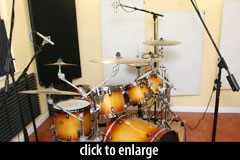 To these tube SDCs, I added a control mic: a pair of AKG C 460 Bs, modded by Jim Williams of Audio Upgrades to have an ultra-fast, extremely neutral transformerless FET circuit. [Note: Jim does not offer commercial mic mods any longer.] This mic was one of my favorites in the aforementioned FET SDC drum OH mic shootout, and has been my go-to neutral SDC ever since.
To these tube SDCs, I added a control mic: a pair of AKG C 460 Bs, modded by Jim Williams of Audio Upgrades to have an ultra-fast, extremely neutral transformerless FET circuit. [Note: Jim does not offer commercial mic mods any longer.] This mic was one of my favorites in the aforementioned FET SDC drum OH mic shootout, and has been my go-to neutral SDC ever since.
I also recorded all these mics with Omni capsules in an AB array, with capsules 65'' above the floor, pointed straight down. Both mics were equidistant from the center of the snare, and were rotated clockwise from the drummer’s perspective so that a line drawn between the mics would be perpendicular to a line drawn from snare to kick.
Audio Files (RM/Cardioid)
Listening Notes (RM/Cardioid)
These notes are the result of extensive blind listening to RMS gain-matched 24-bit WAV files. A few tracks stand out immediately because they have such a characteristic sound — the Mojaves, for that upper midrange peak of the Cardioid capsule, the Lautens for being relatively dark and thick, and the Telefunkens for having the brightest response (especially above 10kHz).
The modified  AKG C 460 B FETs stand out too, not so much for their color, but because they sound awesome. They are the most balanced and natural, with the most pleasing high-frequency response. The mids are meaty, the lows are tight, and the highs are unhyped. In this room, that’s a recipe for a great drum sound. In fact, in a blind test, I picked the AKGs as my favorites of the bunch.
AKG C 460 B FETs stand out too, not so much for their color, but because they sound awesome. They are the most balanced and natural, with the most pleasing high-frequency response. The mids are meaty, the lows are tight, and the highs are unhyped. In this room, that’s a recipe for a great drum sound. In fact, in a blind test, I picked the AKGs as my favorites of the bunch.
I can imagine a session in which a less-natural OH sound, whether due to tube compression or transformer coloration, would win the gig. But today was not that day.
The  Sterling Audio ST44 earns a close second place. This pair sounds slightly less authoritative than the AKGs to my ear, I think because they’re a bit thinner below 200 Hz. But they capture a nice snare crack with smooth highs. I’m impressed with these low-cost mics, and I’m glad to have acquired a pair.
Sterling Audio ST44 earns a close second place. This pair sounds slightly less authoritative than the AKGs to my ear, I think because they’re a bit thinner below 200 Hz. But they capture a nice snare crack with smooth highs. I’m impressed with these low-cost mics, and I’m glad to have acquired a pair.
The  Chameleons seem to hear more of the room sound than the other mics, as if they have a broader Cardioid pickup pattern. The effect gives them a slightly less focused sound. It’s a subtle difference; as noted in previous reports, in the context of a production, with a bit of EQ here and there, any of these mics could be used to excellent effect.
Chameleons seem to hear more of the room sound than the other mics, as if they have a broader Cardioid pickup pattern. The effect gives them a slightly less focused sound. It’s a subtle difference; as noted in previous reports, in the context of a production, with a bit of EQ here and there, any of these mics could be used to excellent effect.
The  Avantones have boosted/colored high mids, similar in effect to the Mojaves. In either case, I’d want to cut above 3 kHz. I actually tried this with a high shelf, and liked it a lot. Subtractive EQ can be your friend.
Avantones have boosted/colored high mids, similar in effect to the Mojaves. In either case, I’d want to cut above 3 kHz. I actually tried this with a high shelf, and liked it a lot. Subtractive EQ can be your friend.
I’ve described some differences in tonal color, but the reality is that I wouldn’t hesitate to use any of these mics on drum overheads. Depending on the production, certain choices would become preferable: tom-heavy jungle vibe, or a cymbal basher? Use the Lautens. Recording a drummer with a light touch, or to tape? Use the Telefunkens. Pro bono session with high school punk band that has never recorded (or even rehearsed)? SM57s on OH. No, I’m not kidding.
FETs vs Tubes
The drums, the groove, the mic position, and the room for these samples are identical to those used in the second part of the Prairie Sun session. I’ve prepared a ZIP archive of gain-matched 24-bit stereo WAVs from both sessions, so you can directly compare the six tube SDCs from this session to six FET SDCs from previously: the Mojave MA-100, sE Electronics sERN17, Earthworks SR40, Nevaton MC49, modded AKG C460B, and modded Oktava MK-012.
Audio Files (AB/Omni)
(This set does not contain the AKG C460B pair, nor the Sterling ST44 pair, because I don’t have omni capsules for these mics.)
Listening Notes (AB/Omni)
I have to say that I don’t love the sound of omni overheads in this small room. This is not a room I want to hear. It’s not a terrible sounding room — I’ve heard worse. Hell, I’ve tracked in worse — but I’d sooner have either a drier OH sound, or a bigger room.
Be that as it may, I set up a blind test of the five tube SDCs for which I had omni capsules, and duly listened. If you’ve been following this review series, you’ll know some of the characteristic sounds we’ve been reporting, and you won’t be surprised that after one pass I was able to correctly identify all five pairs of mics. So much for a blind test.
I’ll call out the  Lauten Torch for, alone among these mics, capturing a huge and punchy kick drum sound. I don’t rely on the OH mics for a kick sound, but if you were going for a minimally-miked aesthetic, you could just about do it: put a good drum kit in a nice room, and hang a spaced pair of Torches with omni capsules, and you’re done: instant stereo drum sound, with little chance of phase issues among the mics.
Lauten Torch for, alone among these mics, capturing a huge and punchy kick drum sound. I don’t rely on the OH mics for a kick sound, but if you were going for a minimally-miked aesthetic, you could just about do it: put a good drum kit in a nice room, and hang a spaced pair of Torches with omni capsules, and you’re done: instant stereo drum sound, with little chance of phase issues among the mics.
My favorite of this set is the  Chameleon Labs TS-1 (Mk II). This is the most natural-sounding track of the bunch, with a smooth and even response from the mids through the high frequencies, and no unwanted boost around 4–8kHz (which is where these high-hats sound nasty).
Chameleon Labs TS-1 (Mk II). This is the most natural-sounding track of the bunch, with a smooth and even response from the mids through the high frequencies, and no unwanted boost around 4–8kHz (which is where these high-hats sound nasty).
Conclusion
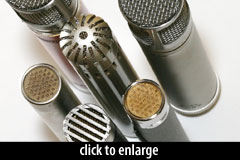 In a roundup populated with premium microphones, we wouldn’t expect to pick a single “winner.” Rather, the goal is to learn how these mics sound, and extrapolate from there whether they are likely to be useful for the sorts of recording we expect to do.
In a roundup populated with premium microphones, we wouldn’t expect to pick a single “winner.” Rather, the goal is to learn how these mics sound, and extrapolate from there whether they are likely to be useful for the sorts of recording we expect to do.
If you’ve followed this 3-part review, you’ve likely come to understand the characteristic performance you could expect from any of these microphones. Add this knowledge to your brand affinities, filter by the realities of your budget, and you’re well on your way to picking a tube SDC that makes you happy in every session.
This roundup included mics from a wide range of price points, from the $299 ST44 to the $1495 ElaM 260. [These are not MSRP, but street prices at the time of publication.] The question must be asked: are the higher-priced mics really worth two to five times more than the entry level? The answer depends on what you value, be it build quality, accessories, warranty, and so on. There’s no question that the cost of each kit rises in parallel with the retail price. For example, I know that David Bock obsesses over the quality of the chrome plating on his Bock Audio mics. You won’t see that sort of attention to detail in any budget microphone. The earlier two parts of this series covered some of these issues, such as potential shortcomings in the design (or mere presence) of the shockmounts.
But the good news for mic buyers is that if budget is a critical issue, there are low-cost mics that can sound great. No, they’re not “as good as” something three times the price, but if treated with care they should deliver years of solid service.
An illustrative aside
I have been pleasantly surprised by the performance of the ST44, which I purchased via Ebay in preparation for this evaluation. But the fact that my pair lives in two tattered cardboard boxes is a source of constant annoyance — and yet the cost of a flightcase with custom diecut foam insert bumps my total investment up to the point where maybe I should have considered buying a higher-priced tube SDC pair in the first place. You know, one of those premium mics that comes with a custom-made flightcase? Oh, the irony.
This is the last of a 3-part series:
- Massive Tube SDC Review
- Omni Tube SDCs on Acoustic Guitar
- Tube Mic Drum Overhead Shootout (you are here)
Thanks again to Telefunken Elektroakustik, Mojave Audio, Lauten Audio, Chameleon Labs, and Avantone Pro for their generous support during the production of this series.
Posted in Drums, Microphones, Shootouts | 4 Comments »



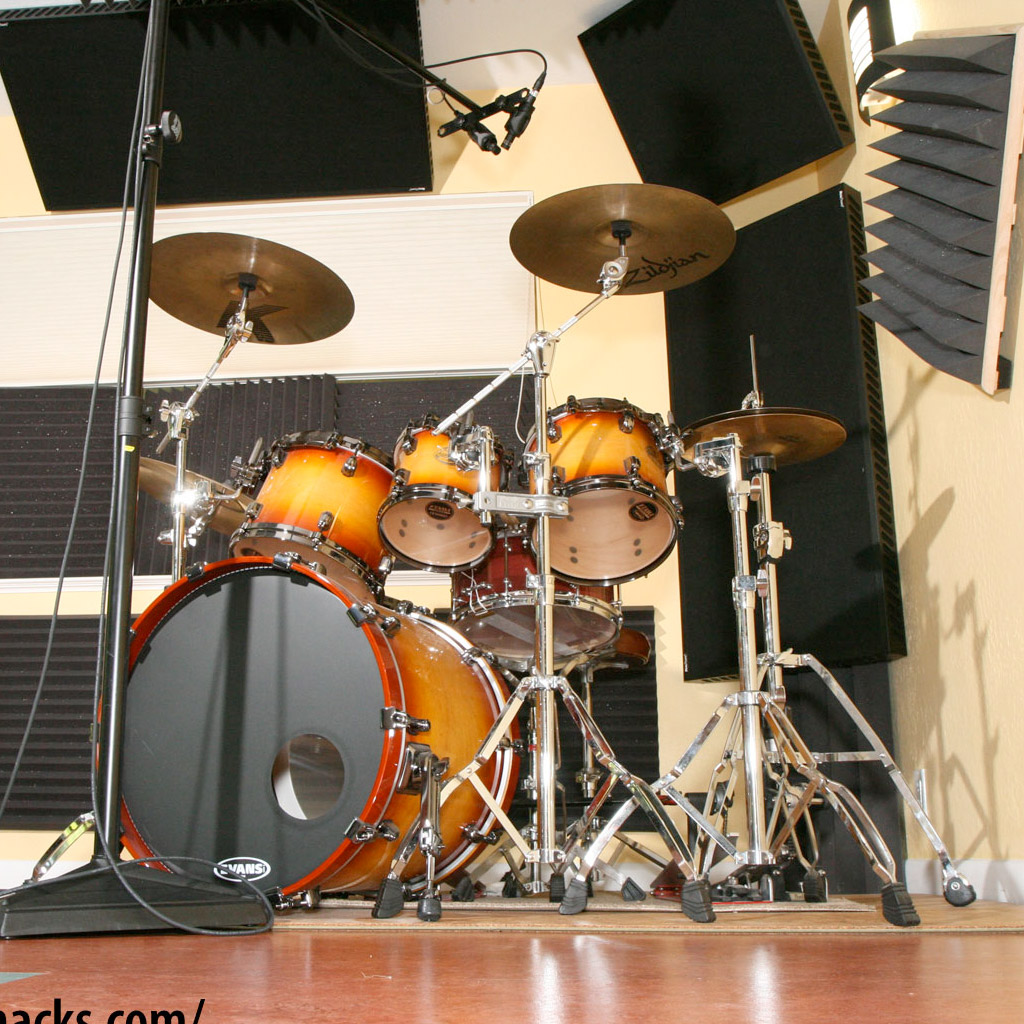
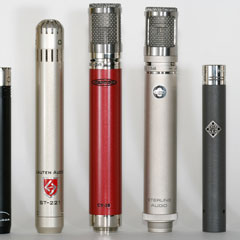
Big Dave
October 8th, 2012 at 5:13 am
The two sets of comparisons mostly sounded the same from microphone to microphone to me. The Lauten Omni’s did pop out in the second comparison, but wow, look at the price.
Joel
October 20th, 2012 at 11:15 am
Again in this test the lower/mid range priced mics were always my winners. Chameleon Labs was always my #1 or #2 choice and I was able to correctly identify it.
I was also able to identify which mics were the Lautens and Telefunkens in the Recorderman test, but the Teles surprised me in the Spaced Pair test. For once, in all of the tests you guys have done, I actually picked it in my top 3.
The competition is now between Avantone and Chameleon Labs for me!
Marcus
December 4th, 2012 at 8:52 pm
Really digging the Avantone sound! Has a bright softness to it on top, which I like, and the low end is pretty beefy. Listen to the kick, for instance, in the AB setup! It’s way thumpier than the rest. It’s fuzzy but in a good way. The Lauten has a good amount of attack to it, though. I’d use that for funk or metal, and the Avantones for acoustic/classic rock type stuff.
Peter
October 15th, 2015 at 6:52 pm
I love and own the torches. I was surprised, they were not my first choice in the blind listening on any of the drum examples, although I thought they sounded great on sax in the earlier portion of this series. I use them on everything, and when I set up drum overheads, its either the torches, C414s or Austin (DIY) ribbon mics. IMHO, they didn’t flatter these drums in this room.
I actually liked the telefunken more than I anticipated. I usually consider Neumann and Telefunken to be overpriced, and just paying for a name brand, but I felt that they really shone in the cardioid example. They didn’t make the snare sound like popcorn, if that analogy makes sense… They avantones were very impressive as well, especially for the price!
Great work on this!